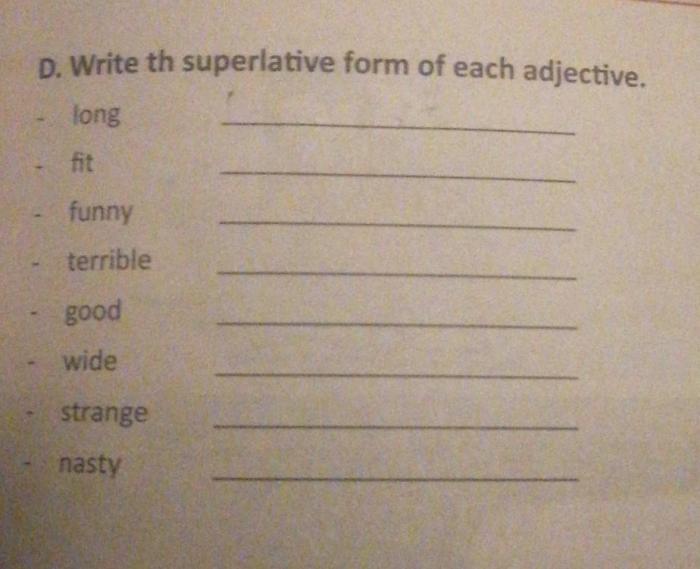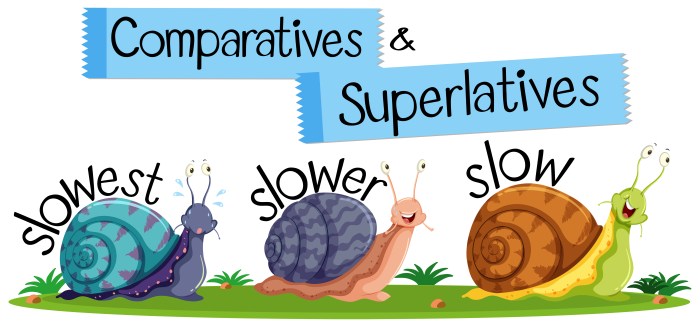Transformar write the superlative form of each adjective – Transformar: Write the Superlative Form of Each Adjective delves into the intricacies of English adjectives, guiding readers through the nuances of comparative and superlative forms. This comprehensive resource empowers writers with the knowledge to convey the utmost degree of qualities, ensuring precision and impact in their written and spoken communication.
With clear explanations, practical examples, and expert insights, Transformar unravels the complexities of adjective forms, enabling readers to master the art of expressing the highest level of intensity, comparison, and emphasis.
Superlative Forms of Adjectives
Superlative forms of adjectives are used to describe the highest or most extreme degree of a quality or characteristic. They are typically formed by adding the suffix “-est” to the base form of the adjective or by using the word “most” before the adjective.
Here is a comprehensive list of superlative forms of common adjectives:
- Best
- Worst
- Biggest
- Smallest
- Tallest
- Shortest
- Heaviest
- Lightest
- Oldest
- Youngest
There are some irregular superlatives that do not follow the “-est” rule. These include:
- Good – Best
- Bad – Worst
- Far – Farthest
- Near – Nearest
- Much – Most
- Little – Least
Comparative and Superlative Forms

Comparative forms of adjectives are used to compare two or more things, while superlative forms are used to compare three or more things. The comparative form is typically formed by adding “-er” to the base form of the adjective or by using the word “more” before the adjective.
The superlative form is typically formed by adding “-est” to the base form of the adjective or by using the word “most” before the adjective.
Here is a table with examples of comparative and superlative forms of adjectives:
| Adjective | Comparative | Superlative |
|---|---|---|
| Tall | Taller | Tallest |
| Short | Shorter | Shortest |
| Big | Bigger | Biggest |
| Small | Smaller | Smallest |
| Heavy | Heavier | Heaviest |
Using Superlative Forms Correctly
Superlative forms should be used sparingly and only when necessary to emphasize a particular quality or characteristic. Overusing superlatives can make your writing sound exaggerated and insincere.
Here are some guidelines for using superlative forms correctly:
- Use superlative forms only when you are comparing three or more things.
- Avoid using superlative forms in a row.
- Be specific about what you are comparing.
- Use superlative forms to emphasize a particular quality or characteristic, not to make a general statement.
Examples of Superlative Forms

- The tallest building in the world is the Burj Khalifa.
- The smallest country in the world is Vatican City.
- The most expensive car in the world is the Bugatti Veyron.
- The least populated continent is Antarctica.
- The most popular sport in the world is soccer.
Adjectives with Irregular Superlatives
Some adjectives have irregular superlative forms. These include:
- Good – Best
- Bad – Worst
- Far – Farthest
- Near – Nearest
- Much – Most
- Little – Least
Using Superlative Forms for Emphasis
Superlative forms can be used to emphasize a particular quality or characteristic. This can be effective in writing and speech when you want to make a strong impression.
Here are some examples of effective use of superlatives for emphasis:
- “The most important thing is to be happy.”
- “The worst thing that could happen is if we lose.”
- “The tallest building in the world is a marvel of engineering.”
Overuse of Superlatives: Transformar Write The Superlative Form Of Each Adjective

Overusing superlatives can make your writing sound exaggerated and insincere. It can also make it difficult for your readers to distinguish between what is truly important and what is not.
Here are some tips on how to avoid excessive use of superlatives:
- Use superlative forms sparingly.
- Only use superlative forms when necessary to emphasize a particular quality or characteristic.
- Be specific about what you are comparing.
- Avoid using superlative forms in a row.
Questions and Answers
What are the key differences between comparative and superlative forms of adjectives?
Comparative forms compare two items, while superlative forms compare three or more items. Superlative forms typically use the suffix “-est” or the word “most.”
How can I avoid overusing superlatives in my writing?
Use superlatives sparingly to maintain a balanced writing style. Consider using more specific and descriptive language instead.